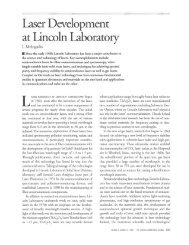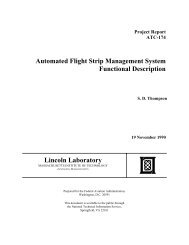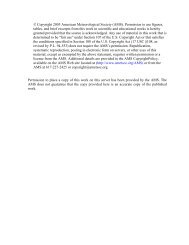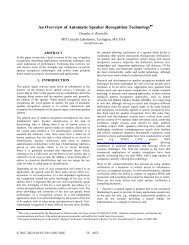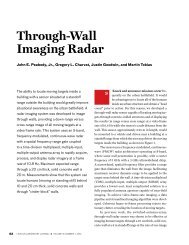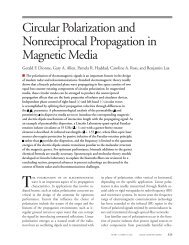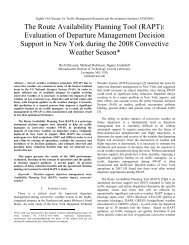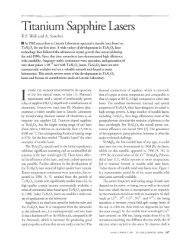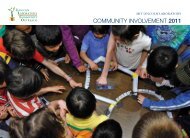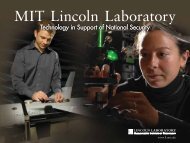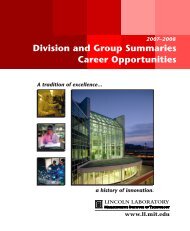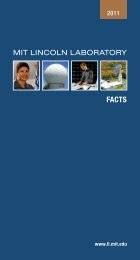2011 Annual Report - MIT Lincoln Laboratory
2011 Annual Report - MIT Lincoln Laboratory
2011 Annual Report - MIT Lincoln Laboratory
Create successful ePaper yourself
Turn your PDF publications into a flip-book with our unique Google optimized e-Paper software.
technology investments<br />
Emerging Research Thrusts<br />
The <strong>2011</strong> investments focused on three areas that exploit the <strong>Laboratory</strong>’s strengths in sensors<br />
and communication technologies and that address emerging threats to national security.<br />
Autonomous Systems<br />
Autonomous systems couple unmanned aerial, ground,<br />
and maritime vehicles with autonomy algorithms and<br />
technologies to enable new system capabilities and<br />
amplify the effectiveness of human-robot teams. The<br />
<strong>Laboratory</strong>’s autonomous system effort is focused on<br />
robust operation of autonomous systems in complex<br />
and unpredictable environments; enhanced understanding<br />
and trust between humans and robots; and<br />
persistent, shared perception and reasoning.<br />
Recent key accomplishments include<br />
■ A 22 km demonstration of an autonomous ground<br />
vehicle’s route re-traversal while the vehicle<br />
maintains a standoff distance ahead of a manned<br />
follower vehicle. The milestone is part of a project<br />
investigating robust navigation through unstructured<br />
outdoor terrain.<br />
■ The transfer of robot-based, GPS-denied, mapping<br />
technology to a mission-focused advanced<br />
technology demonstration. In a collaborative effort<br />
with <strong>MIT</strong> campus, the mapping technology is being<br />
extended to a body-worn system with video and<br />
lidar sensors.<br />
10 <strong>2011</strong> <strong>Annual</strong> <strong>Report</strong><br />
■ The application of a cognitive functional model of<br />
inner rehearsal to solve a simulated robotic searchand-rescue<br />
task. The experiment illustrates an<br />
alternative bioinspired approach to autonomy that<br />
seeks to effect artificial cognition through emulation<br />
of human cognitive and neural processes.<br />
Quantum Information Science<br />
Quantum information science (QIS) addresses the<br />
investigation and application of quantum mechanical<br />
phenomena for the purposes of sensing, communicating,<br />
and processing information in ways that<br />
dramatically exceed conventional, classical means.<br />
There is significant national interest in the long-term<br />
applications of QIS technologies, and the <strong>Laboratory</strong><br />
continues to make targeted investments in QIS.<br />
The <strong>Laboratory</strong> continued to distinguish itself in the<br />
QIS area with<br />
■ Improvements in the design, materials science,<br />
fabrication, and testing of superconducting qubits, a<br />
leading “artificial atom” technology manufactured in<br />
the Microelectronics <strong>Laboratory</strong>. In a collaboration<br />
with <strong>MIT</strong> campus and NEC Japan, experiments<br />
demonstrated advanced microwave methods with<br />
BELOW, FROM LEFT:<br />
A Black-I Robotics<br />
Landshark ground<br />
platform with custom<br />
<strong>Laboratory</strong> hardware and<br />
autonomy algorithms<br />
serves as an extensible<br />
outdoor autonomous<br />
ground-vehicle test bed;<br />
a new laboratory space<br />
housing a magnetooptical<br />
trap (MOT) is<br />
enabling work in trappedion<br />
quantum computing.<br />
Here, strontium ions are<br />
held in a MOT before<br />
being individually loaded<br />
into a superconducting<br />
ion trap that operates at a<br />
temperature of 4.5 Kelvin.



